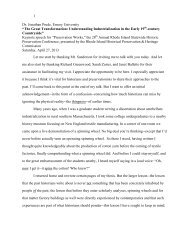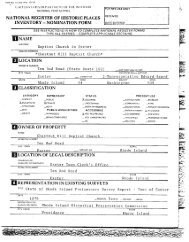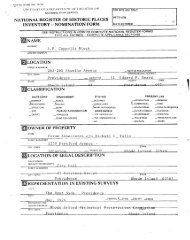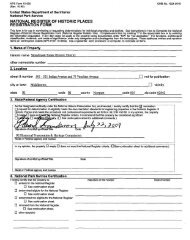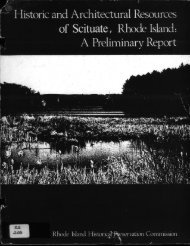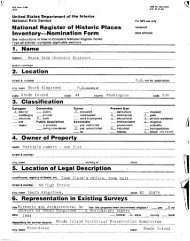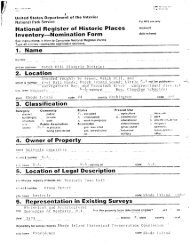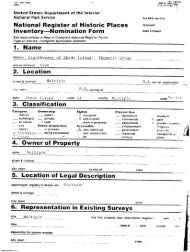National Register of Historic Places Registration Form
National Register of Historic Places Registration Form
National Register of Historic Places Registration Form
Create successful ePaper yourself
Turn your PDF publications into a flip-book with our unique Google optimized e-Paper software.
NFS <strong>Form</strong> 1040048-86United States Department <strong>of</strong> the Interior<strong>National</strong> Park ServiCe<strong>National</strong> <strong>Register</strong> <strong>of</strong> <strong>Historic</strong> <strong>Places</strong>Continuation Sheet0MB ApproIt NO. 14COIIPropertyname Clement Weaver - Daniel Howland House, Kent County. P.1.Section number 7 * Page 5DescriptionThe Clement Weaver House, originally constructed in 1679, is a storyand-a-halfclapboarded and shingled house with a gable ro<strong>of</strong>, a large stoneand brick chimney approximately at its center and a single-story ell, witha massive stone end chimney, on the south. The house is in goodcondition, retaining overall integrity <strong>of</strong> its seventeenth-century design,materials, workmanship and appearance on its original site. The housefaces east and is set back approximately fifty feet from Howland Road in arural, residential area. Woods behind the house and simple landscapingprovide an appropriate immediate setting. A well in front east <strong>of</strong> thesouthern ell and a non-contributing, twentieth-century, one-story shingledframe garage south <strong>of</strong> the house and close to the road comprise the othervisible structural features on the 1 1/2-acre property.The main section <strong>of</strong> the house as it presently appears has an atypicaland asymmetrical five-bay facade, and a lopsided five-room, center-chimneyplan. Both the facade and the plan are the result <strong>of</strong> four different phases<strong>of</strong> construction. The first section <strong>of</strong> the house was a single great roomwith a tall half-story garret above; the huge stone and brick chimney, now<strong>of</strong>f-center in the house, originally rose just inside its northern end.Norman Isham, Rhode Island’s pioneer architectural historian, studied thehouse in the l930s and probably supervised some restoration work. Thefirst addition to the house was a single-story lean-to across the northernside <strong>of</strong> the chimney. This was very soon lengthened and its ro<strong>of</strong> raised toprovide a second garret united with the southern garret under a common ro<strong>of</strong>but reached by a separate straight-run staircase see plan . The fourthchange was the addition <strong>of</strong> a lean-to across the rear <strong>of</strong> the house, givingthe ro<strong>of</strong>line a saltbox pr<strong>of</strong>ile and adding three more rooms on the firstfloor. The final phase <strong>of</strong> building was the addition <strong>of</strong> the southern ell,with its own massive stone fireplace. Windows in both the main block andell are 6/6 or 12/12 double hang sash, with the exception <strong>of</strong> two restoredcasements discussed below.Entry to the main section <strong>of</strong> the house is through a shallow enclosedporch located in the approximate center <strong>of</strong> the east facade; a deeperenclosed porch at the south corner provides access to the cellar. The mainentrance opens directly into a wide but shallow stair hall. Ahead rise theseparate garret staircases, straight runs <strong>of</strong> seven stairs on the south andeight stairs on the -north, which meet at the bottom in an awkward wedgeshape. These stairs were originally enclosed by floor-to-ceiling verticalsheathing and a board-and-batten door; but, in a change made sometime after






